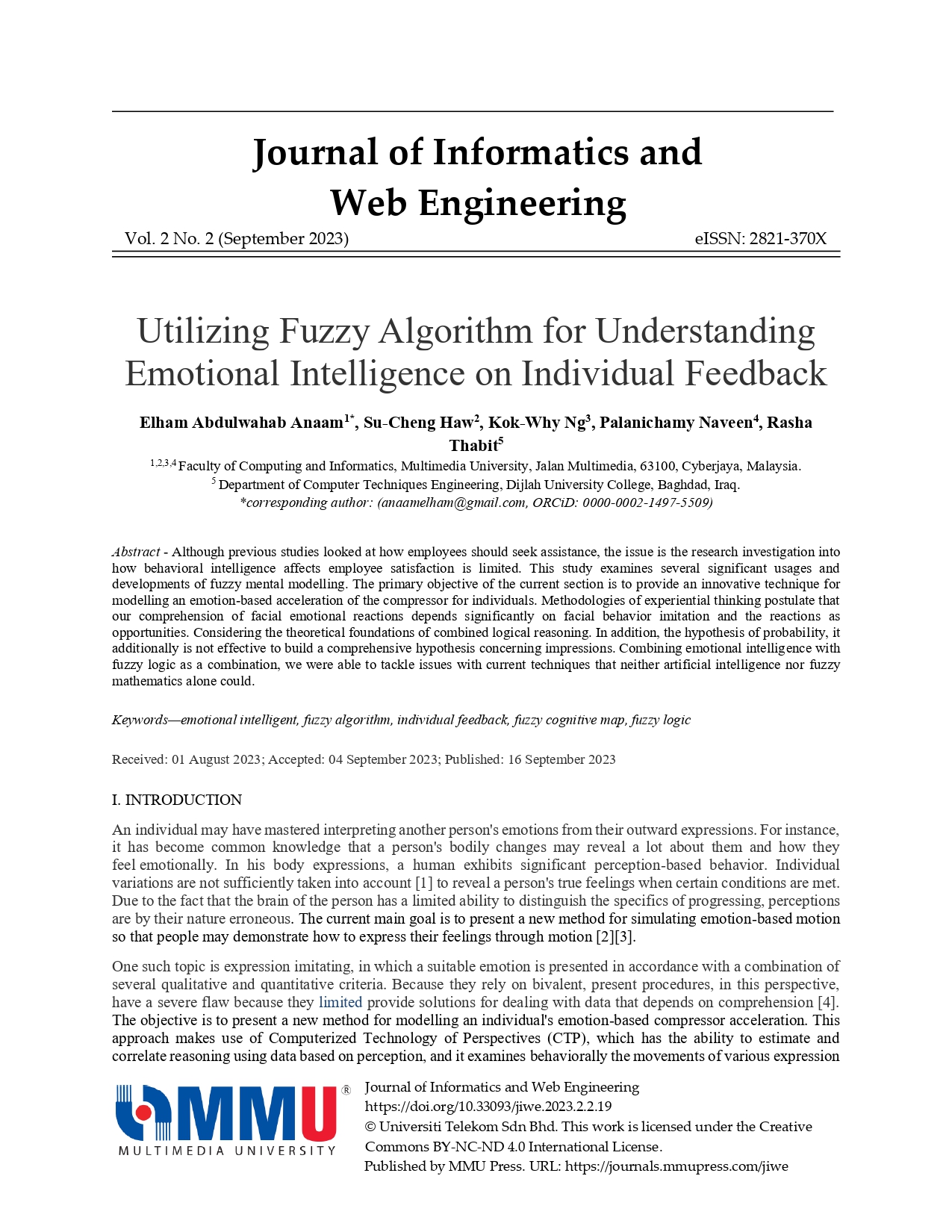Utilizing Fuzzy Algorithm for Understanding Emotional Intelligence on Individual Feedback
Main Article Content
Abstract
Although previous studies looked at how employees should seek assistance, the issue is the researchinvestigation into how behavioral intelligence affects employee satisfaction is limited. This study examines several significant usages and developments of fuzzy mental modelling. The primary objective of the current section is to provide an innovative technique for modelling an emotion-based acceleration of the compressor for individuals. Methodologies of experiential thinking postulate that our comprehension of facial emotional reactions depends significantly on facial behavior imitation and the reactions as opportunities. Considering the theoretical foundations of combined logical reasoning. In addition, the hypothesis of probability, it additionally is not effective to build a comprehensive hypothesis concerning impressions. Combining emotional intelligence with fuzzy logic as a combination, we were able to tackle issues with current techniques that neither artificial intelligence nor fuzzy mathematics alone could.
Article Details

This work is licensed under a Creative Commons Attribution-NonCommercial-NoDerivatives 4.0 International License.
All articles published in JIWE are licensed under a Creative Commons Attribution-NonCommercial-NoDerivatives 4.0 International (CC BY-NC-ND 4.0) License. Readers are allowed to
- Share — copy and redistribute the material in any medium or format under the following conditions:
- Attribution — You must give appropriate credit, provide a link to the license, and indicate if changes were made. You may do so in any reasonable manner, but not in any way that suggests the licensor endorses you or your use;
- NonCommercial — You may not use the material for commercial purposes;
- NoDerivatives — If you remix, transform, or build upon the material, you may not distribute the modified material.
References
B. Dudzik, M. Jansen, F. Burger, F. Kaptein, “Context in Human Emotion Perception for Automatic Affect Detection: A Survey of Audiovisual Databases,” International Conference on Affective Computing and Intelligent Interaction (ACII), no. 639, pp. 206-212, 2019. doi: 10.1109/ACII.2019.8925446.
S. C. Haw, L. J. Chew, K. Ong, K. W. Ng, P. Naveen, E. A. Anaam, “Content-based Recommender System with Descriptive Analytics,” Journal of System and Management Sciences, vol. 12, no. 5, pp. 105–120, 2022. doi: 10.33168/JSMS.2022.0507.
A. Hinduja and M. Pandey, “An Intuitionistic Fuzzy AHP based Multi Criteria Recommender System for Life Insurance Products,” International Journal of Advanced Studies in Computers, Science and Engineering, vol. 7, no. 1, pp. 1-8, 2018.
X. Ma, E. Y. Yang, P. Fung, “Exploring Perceived Emotional Intelligence of Personality-Driven Virtual Agents in Handling User Challenges,” The World Wide Web Conference, pp. 1222-1233, 2019. https://doi.org/10.1145/3308558.3313400
B. Choi, "Humanoid Robots", InTech, 2009. doi: 10.5772/108
M. Kuehne, I. Siwy, T. Zaehle, H. Heinze, J. Lobmaier, “Out of Focus: Facial Feedback Manipulation Modulates Automatic Processing of Unattended Emotional Faces,” no. 1974, pp. 1–10, 2015. doi: 10.1162/jocn.
A. Z. Zakuan, S. Abdul-Rahman, H. Jantan, “Towards academic successor selection modelling with Genetic Algorithm in multi-criteria problems,” International Journal of Engineering and Technology, vol. 7, no. 4, pp. 130–133, 2018. doi: 10.14419/ijet.v7i4.33.23516.
I. T. Boz, A. Ayan, I. Eskin, G. Kahraman, “The effect of the level of self-monitoring on work engagement and emotional exhaustion: A Research on Small and Medium Size Enterprises (SMEs),” Procedia-Social and Behavioral Sciences, vol. 150, pp. 1080–1089, 2014. doi: 10.1016/j.sbspro.2014.09.122.
Z. Fayyaz, M. Ebrahimian, D. Nawara, A. Ibrahim, and R. Kashef, “Recommendation systems: Algorithms, challenges, metrics, and business opportunities,” Applied sciences, vol. 10, no. 21, pp. 1–20, 2020. doi: 10.3390/app10217748.
D. Roy and M. Dutta, “A systematic review and research perspective on recommender systems,” Journal of Big Data, vol. 9, no. 1, 59, 2022. doi: 10.1186/s40537-022-00592-5.
P. Sethi and S. R. Sarangi, “Internet of Things:Architectures, Protocols, and Applications,” Journal of Electrical and Computer Engineering, vol. 2017,no. 1, pp. 1-25, 2017. https://doi.org/10.1155/2017/9324035
M. B. Mollah et al., “Blockchain for the Internet of Vehicles Towards Intelligent Transportation Systems: A Survey,” IEEE Internet of Things Journal, vol. 8, no. 6, pp. 4157–4185, 2021.doi: 10.1109/JIOT.2020.3028368.
O. N. Jensen, P. Mortensen, O. Vorm, M. Mann, “Automation of Matrix-Assisted Laser Desorption / Ionization Mass Spectrometry Using Fuzzy Logic Feedback Control,” vol. 69, no. 9, pp. 1706–1714, 1997. https://doi.org/10.1021/ac961189t
M. Bagheri, A. Akbari, and S. A. Mirbagheri, “Advanced control of membrane fouling in filtration systems using artificial intelligence and machine learning techniques: A critical review,” Process Safety and Environmental Protection, vol. 123, pp. 229-252, 2019. doi: 10.1016/j.psep.2019.01.013.
J. Singh and A. Sharan, “A new fuzzy logic-based query expansion model for efficient information retrieval using relevance feedback approach,” Neural Computing and Applications,vol. 28, pp. 2557-2580, 2016. doi: 10.1007/s00521-016-2207-x.
G. Albertus, M. Meiring, H. C. Myburgh, “A Review of Intelligent Driving Style Analysis Systems and Related Artificial Intelligence Algorithms,” pp. 30653–30682, 2015. doi: 10.3390/s151229822.
F. Ali, S. El-Sappagh, S.M.R. Islam, A. Ali, M. Attique, M. Imran, K.S. Kwak, "An intelligent healthcare monitoring framework using wearable sensors and social networking data", Future Generation Computer Systems, vol. 114pp. 23-43, 2021. doi: 10.1016/j.future.2020.07.047.
J. Martinez-Miranda and A. Aldea,“Emotions in human and artificial intelligence,” Computers in Human Behavior, vol. 21,no. 2, pp. 323–341, 2005. doi: 10.1016/j.chb.2004.02.010.
M. G. Bitmi and A. Ergeneli, “Emotional Intelligence: Reassessing the construct validity,” Procedia-Social and Behavioral Sciences, vol. 150, pp. 1090–1094, 2014. doi: 10.1016/j.sbspro.2014.09.123.
I. Pastor, “Leadership and emotional intelligence: the effect on performance and attitude,” Procedia Economics and Finance, vol. 15, no. 14, pp. 985–992, 2014. doi: 10.1016/S2212-5671(14)00658-3.
F. C. J. Cabibihan et al., "Social Robotics", International Conference on Social Robotics, 2022. doi: 10.1007/978-3-031-24667-8.
A. Zenebe and A. F. Norcio, “Representation , similarity measures and aggregation methods using fuzzy sets for content-based recommender systems,” Fuzzy Sets and Systems, vol. 160,no. 1, pp. 76–94, 2009. doi: 10.1016/j.fss.2008.03.017.
Y. Lim, K.W. Ng, P. Naveen, S.C. Haw, “Emotion Recognition by Facial Expression and Voice: Review and Analysis”, Journal of Informatics and Web Engineering, Vol. 1 No. 2, pp. 45 – 54, 2022. https://doi.org/10.33093/jiwe.2022.1.2.4

